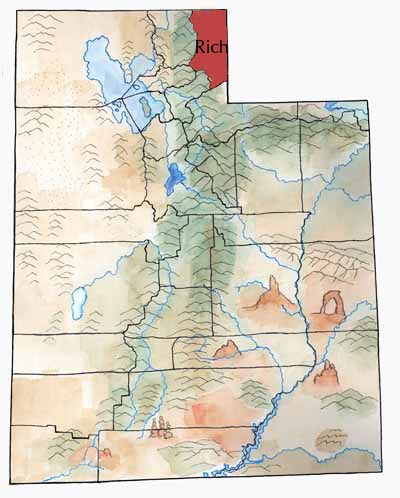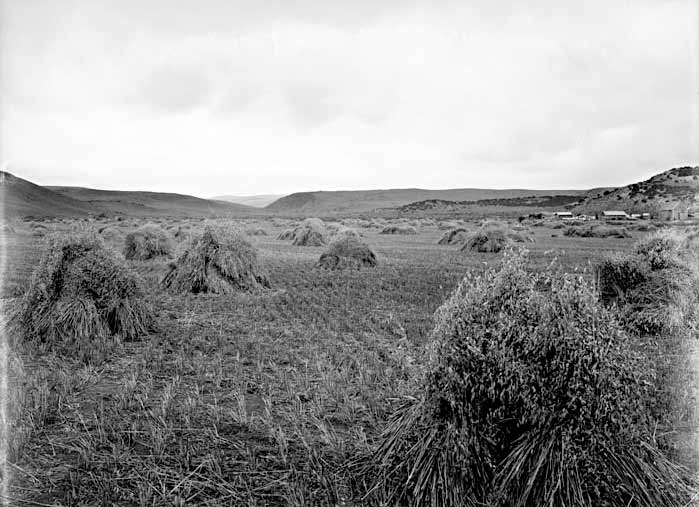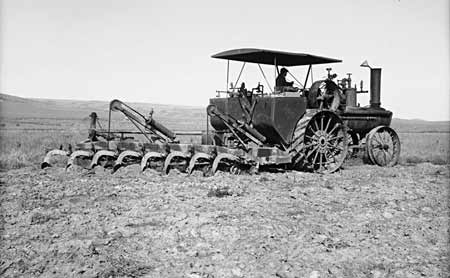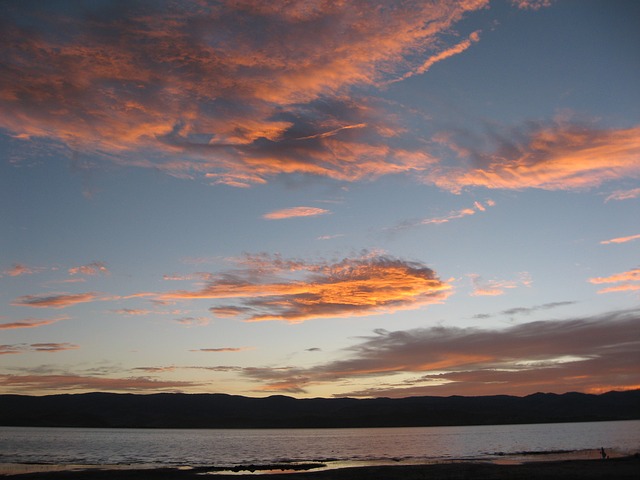Rich County, in the northeast corner of Utah, occupies a narrow area about 18 miles wide and 56 miles long. Wyoming lies to the east and Idaho lies to the north.

Along the Bear River the land is wide, with large vistas. Not many people live here.
In the north, the beautiful Bear Lake Valley lies between mountain ranges. The turquoise-blue lake is about 18 miles long, 7 miles wide, and 200 feet deep. Half of it lies in Rich County, and the other half in Idaho.
First Peoples
Hunter-gatherer groups lived in and traveled through this area as early as 10,000 years ago. Fremont Indians occupied the land 1,000 years ago. Near Woodruff, there is a fascinating prehistoric site called a “buffalo jump.” Here, indigenous hunters drove herds of bison over a cliff. They then took meat and hides from the dead animals, leaving many bones behind.

Later, Bannock and Shoshone Indians used the land around Bear River and Bear Lake for hunting. Here they found plenty of big game, ducks and geese, and fish.
Early Eruo-Americans
Fur trappers from the Hudson Bay Company visited Bear Lake as early 1812. Because so many black bears lived in the area, the trappers called it Black Bear Lake. The valley also had lots of beaver and other game, so it naturally became a favorite area for trappers seeking beaver pelts. In 1827 and 1828, trappers held their annual rendezvous on the south shore of the lake.
In the early 1840s the Oregon Trail—the route thousands of immigrants took on their way to the Northwest—cut through a corner of Rich County. Thomas L. “Peg Leg” Smith, perhaps the first Euro American to settle in the valley, took advantage of the immigrant traffic. In 1848 he started a cattle business, trading post, and horse exchange on the Bear River near present Dingle, Idaho.

Settlers
When Congress passed the Homestead Act of 1862, Brigham Young wanted Mormons to get control of the land before non-Mormons did. In August 1863 he called Charles C. Rich to lead an exploring party into the Bear Lake Valley to select a site for settlement. Rich chose land near the present Paris, Idaho, for the first town. Rich agreed with the Bannock and Shoshone Indians that Mormons could settle in that area and leave most of the valley to the Indians.
But settlement did not stop at Paris. Soon, other towns sprang up, including Round Valley in 1863; Kennedyville (Garden City) and Laketown, 1864; Woodruff, 1865; Randolph, 1870; and Argyle, 1875.

Cold, long, snowy winters limited the number of settlers who came to Rich County, though. Woodruff averages only 57 frost-free days a year and holds the record for the coldest temperature ever recorded in one of the state’s towns (-50 F. degrees on February 6, 1899).
Economy
Even though much of Rich County is high in elevation and cold, its fertile valleys support farms, alfalfa fields, and livestock. Most of the land is used for agriculture, especially grazing. Much of the county’s income comes from livestock and livestock products.
Since the 1970s, Bear Lake has grown as a resort and recreation area. Thousands of summer visitors come to enjoy the lake, boat, golf, and eat fresh raspberries. Bear Lake State Park includes two beaches and a marina.

Future of Bear Lake
Pressure from all sides on Bear Lake has led to environmental problems. The desires of water users conflict with the desires of recreational users, and both have negatively affected the lake. Early on, Utah Power and Light (now Pacificorp) received rights to store, pump, and use Bear River water. This use—combined with drought—has drastically drawn down the lake levels.
Pacificorp and commercial and residential use have damaged the lake’s ecosystem. All the stakeholders are trying to work out the issues, but this multifaceted lake, which has been called a “jewel of the high mountain valleys,” faces an uncertain future.
Did you Know?
| Joseph C. Rich (son of Mormon leader Charles C. Rich) said, “Only men with plenty of hair on ‘em are tough enough to stand the climate of Bear Lake, but what a country!” |
| This same Joseph Rich began publicizing the “wonderful first-class lie” of the Bear Lake monster in 1868. |
| At early dances, local LDS church leaders outlawed “Swinging with one arm around the lady’s waist.” They also said, “To swing a lady more than once against her will shall be considered ungentlemanly.” |
| LDS church leader Wilford Woodruff caught and lost an enormous trout near Randolph—or at least, that’s the fish story. |
| Bear Lake is not a popular destination for tourists and Utahns alike. |
Fast Facts
Area: 1,034 Square Miles
County Seat: Randolph
Where it Got its Name: either the county was named for the fertility of the Bear River Valley (originally called Richland) or after Charles C. Rich, an LDS apostle who was instramental in the settlement of the Bear Lake area.
Keep Exploring!
Return to the County’s home page here.
Return to the I Love Utah History home page here.